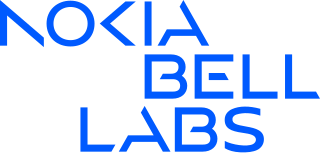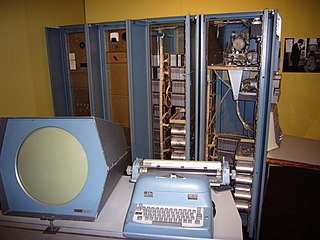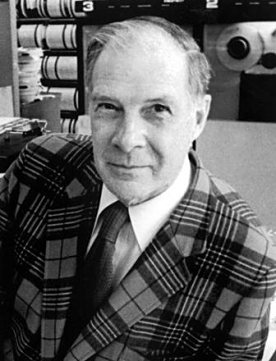
Bell Labs is an American industrial research and development (R&D) company, currently operating as a subsidiary of Finnish technology company Nokia. With a long history, Bell Labs is credited with the development of radio astronomy, the transistor, the laser, the photovoltaic cell, the charge-coupled device (CCD), information theory, the Unix operating system, and the programming languages B, C, C++, S, SNOBOL, AWK, AMPL, and others, throughout the 20th century. Ten Nobel Prizes and five Turing Awards have been awarded for work completed at Bell Laboratories.

The history of computing hardware spans the developments from early devices used for simple calculations to today's complex computers, encompassing advancements in both analog and digital technology.

Programmed Data Processor (PDP), referred to by some customers, media and authors as "Programmable Data Processor," is a term used by the Digital Equipment Corporation from 1957 to 1990 for several lines of minicomputers.

The LINC is a 12-bit, 2048-word transistorized computer. The LINC is considered by some to be the first minicomputer and a forerunner to the personal computer. Originally named the Linc, suggesting the project's origins at MIT's Lincoln Laboratory, it was renamed LINC after the project moved from the Lincoln Laboratory. The LINC was designed by Wesley A. Clark and Charles Molnar.

The TX-0, for Transistorized Experimental computer zero, but affectionately referred to as tixo, was an early fully transistorized computer and contained a then-huge 64K of 18-bit words of magnetic-core memory. Construction of the TX-0 began in 1955 and ended in 1956. It was used continually through the 1960s at MIT. The TX-0 incorporated around 3,600 Philco high-frequency surface-barrier transistors, the first transistor suitable for high-speed computers. The TX-0 and its direct descendant, the original PDP-1, were platforms for pioneering computer research and the development of what would later be called computer "hacker" culture. For MIT, this was the first computer to provide a system console which allowed for direct interaction, as opposed to previous computers, which required the use of punched card as a primary interface for programmers debugging their programs. Members of MIT's Tech Model Railroad Club, "the very first hackers at MIT", reveled in the interactivity afforded by the console, and were recruited by Marvin Minsky to work on this and other systems used by Minsky's AI group.

Richard Wesley Hamming was an American mathematician whose work had many implications for computer engineering and telecommunications. His contributions include the Hamming code, the Hamming window, Hamming numbers, sphere-packing, Hamming graph concepts, and the Hamming distance.
A stored-program computer is a computer that stores program instructions in electronically, electromagnetically, or optically accessible memory. This contrasts with systems that stored the program instructions with plugboards or similar mechanisms.

The Z3 was a German electromechanical computer designed by Konrad Zuse in 1938, and completed in 1941. It was the world's first working programmable, fully automatic digital computer. The Z3 was built with 2,600 relays, implementing a 22-bit word length that operated at a clock frequency of about 5–10 Hz. Program code was stored on punched film. Initial values were entered manually.

BARK was an early electromechanical computer. BARK was built using standard telephone relays, implementing a 32-bit binary machine. It could perform addition in 150 ms and multiplication in 250 ms. It had a memory with 50 registers and 100 constants. It was later expanded to double the memory. Howard Aiken stated in reference to BARK "This is the first computer I have seen outside Harvard that actually works."

The IAS machine was the first electronic computer built at the Institute for Advanced Study (IAS) in Princeton, New Jersey. It is sometimes called the von Neumann machine, since the paper describing its design was edited by John von Neumann, a mathematics professor at both Princeton University and IAS. The computer was built under his direction, starting in 1946 and finished in 1951. The general organization is called von Neumann architecture, even though it was both conceived and implemented by others. The computer is in the collection of the Smithsonian National Museum of American History but is not currently on display.

George Robert Stibitz was an American researcher at Bell Labs who is internationally recognized as one of the fathers of the modern digital computer. He was known for his work in the 1930s and 1940s on the realization of Boolean logic digital circuits using electromechanical relays as the switching element.

The ORACLE or Oak Ridge Automatic Computer and Logical Engine, an early computer built by Oak Ridge National Laboratory, was based on the IAS architecture developed by John von Neumann.
Edmund Callis Berkeley was an American computer scientist who co-founded the Association for Computing Machinery (ACM) in 1947. His 1949 book Giant Brains, or Machines That Think popularized cognitive images of early computers. He was also a social activist who worked to achieve conditions that might minimize the threat of nuclear war.
Theory and Techniques for Design of Electronic Digital Computers was a course in the construction of electronic digital computers held at the University of Pennsylvania's Moore School of Electrical Engineering between July 8, 1946, and August 30, 1946, and was the first time any computer topics had ever been taught to an assemblage of people. The course disseminated the ideas developed for the EDVAC and initiated an explosion of computer construction activity in the United States and internationally, especially in the United Kingdom.

A transistor computer, now often called a second-generation computer, is a computer which uses discrete transistors instead of vacuum tubes. The first generation of electronic computers used vacuum tubes, which generated large amounts of heat, were bulky and unreliable. A second-generation computer, through the late 1950s and 1960s featured circuit boards filled with individual transistors and magnetic-core memory. These machines remained the mainstream design into the late 1960s, when integrated circuits started appearing and led to the third-generation computer.
The Model K was an early 2-bit binary adder built in 1937 by Bell Labs scientist George Stibitz as a proof of concept, using scrap relays and metal strips from a tin can. The "K" in "Model K" came from "kitchen table", upon which he assembled it.
Ruth A. Weiss is a British-American software engineer known for her work in computer graphics, especially the hidden-line removal problem. She also developed, together with Richard Hamming, the L2 programming language, a floating-point mathematical package for the IBM 650.

Perry Orson Crawford, Jr. was an American computer pioneer credited as being the first to fully realize and promote the value of digital, as opposed to analog, computers for real-time applications. This was in 1945 while advising Jay Forrester in developing flight simulators and anti-aircraft fire control devices during World War II, before practical digital computers had been produced. His similar foresight on related issues led to his heading twelve years later the design team for IBM's SABRE project, the ticketing system for American Airlines, the first large-scale commercial application of real-time computer systems, which became the model for on-line transaction processing.
Samuel Lubkin (1906-1972) was a mathematician and computer scientist instrumental in the early history of computing.













